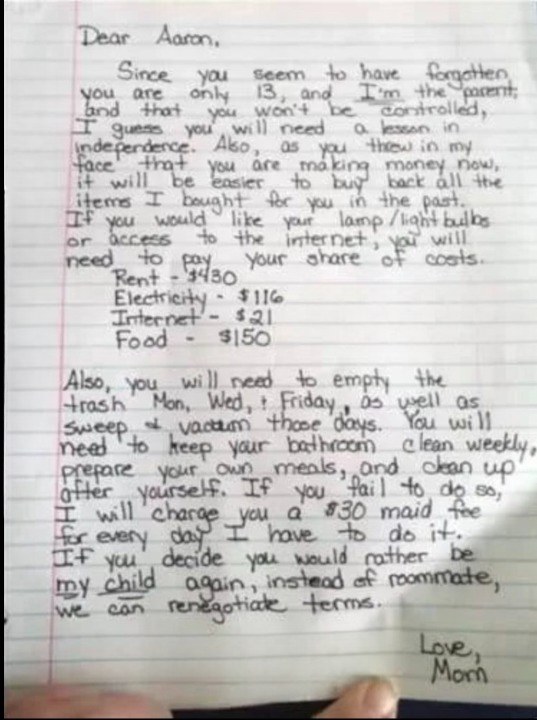Introduction
Growing up often looks deceptively easy to children and teenagers. To them, the lights at home simply turn on with the flick of a switch, Wi-Fi is always available for endless streaming and gaming, and food somehow appears on the table every day. What many young people don’t realize is the amount of time, effort, money, and emotional investment that parents put in to make all of those everyday comforts possible.
For one mother, however, this disconnect between her teenage son’s perception of adulthood and the actual reality of it became too large to ignore. Instead of resorting to endless lectures, she decided to teach her son a practical, unforgettable lesson—one that has since gone viral multiple times and continues to resonate with parents across the world nearly a decade later.
This is the story of Heidi Johnson and her son Aaron, and the powerful handwritten note she taped to his bedroom door that became an unexpected global parenting sensation.
The Backstory: A Clash Between Independence and Responsibility
In 2015, Heidi Johnson was navigating the daily challenges of raising her 13-year-old son, Aaron. Like many teenagers his age, Aaron was beginning to seek independence. He had recently started earning a small income through his YouTube channel—a proud achievement for him and a source of confidence.
But with that new income also came a new attitude. Aaron began resisting his mother’s rules. Simple requests such as finishing homework, helping with chores, or respecting household routines suddenly seemed to him unnecessary. In his eyes, he was becoming a self-sufficient young man who didn’t need to be “controlled.”
One particular day, after a disagreement with his mother, Aaron stormed out of her room, boldly declaring that he was “a free person” because he was “making money now.”
For Heidi, this was a turning point. She realized that traditional lectures about responsibility were no longer effective. Instead, she came up with a different plan—a lesson that combined tough love, humor, and realism.
The Letter That Started It All
Instead of arguing further, Heidi decided to put her message in writing. She crafted a mock “roommate contract” in the form of a letter and taped it to her son’s bedroom door. The note was both poignant and practical, outlining what Aaron’s new life of “independence” would look like if he truly wanted to live as a self-sufficient adult.
The letter began with a direct but loving tone:
“Since you seem to have forgotten you are only 13, and I’m the parent, and that you won’t be controlled, I guess you will need a lesson in independence.”
She went on to explain that since Aaron had reminded her of his ability to earn money, it should be “easier for you to buy back all the items I bought for you in the past.”
The letter included clear conditions:
- If Aaron wanted to use lamps or lightbulbs in his room, or continue enjoying internet access, he would need to contribute to household bills.
- He would be expected to pay his share of rent, utilities, and groceries.
- He would need to cook his own meals and maintain his living space, including cleaning and laundry.
The note concluded simply:
“Love, Mom.”
It wasn’t written to shame him, but to mirror the responsibilities adults face every day. By presenting his life in terms of costs and obligations, Heidi hoped to bridge the gap between Aaron’s idealized view of adulthood and the reality of it.
Aaron’s Reaction: From Rebellion to Reflection
At first, Aaron was furious. When he discovered the note taped to his door, he crumpled it up, tossed it aside, and stormed out of their home in anger.
But while he cooled off, Heidi quietly entered his room and began removing certain belongings—his video game console, favorite gadgets, and other luxuries he loved. These weren’t punishments, but rather visual reminders that the comforts he enjoyed didn’t come without cost.
When Aaron returned, his attitude was noticeably different. Instead of continuing the standoff, he approached his mother with humility. He admitted that he had overreacted, asked what he could do to regain his privileges, and even handed her a few items she had missed during her repossession.
For Heidi, this was the breakthrough she had hoped for. She hadn’t wanted repayment or punishment—she wanted understanding. And in that moment, Aaron realized that true independence requires responsibility, discipline, and financial awareness.
Why the Letter Went Viral
Shortly after writing it, Heidi decided to share the letter on her personal Facebook page. She hoped it might inspire a few friends or spark discussion among fellow parents. What she didn’t expect was that her post would be shared thousands of times within days, and that media outlets worldwide would pick up the story.
Nearly a decade later, the letter continues to resurface online, each time reigniting debates about parenting styles, teenage independence, and the importance of teaching children about the realities of adulthood.
So why did this simple handwritten note strike such a powerful chord?
- It was relatable. Almost every parent of teenagers has faced similar struggles—kids wanting freedom without responsibility.
- It was creative. Instead of yelling or grounding her son, Heidi used humor and practicality to deliver her message.
- It was universal. The themes of gratitude, responsibility, and respect cut across cultures and generations.
Internet Reactions: Praise and Criticism
The responses to Heidi’s letter were passionate and diverse.
Praise
Many parents applauded her for taking a firm but constructive approach:
- “Great job. Nothing in your note was cruel — it’s a real-life lesson he’ll carry forever.”
- “You gave your son a chance to learn and grow instead of just punishing him.”
- “Bravo for being a parent instead of acting like his maid.”
These supporters felt that Heidi’s lesson would leave a lasting impact on her son, teaching him gratitude and preparing him for adulthood.
Criticism
Not everyone approved, however. Some critics accused Heidi of publicly shaming her son by posting about the incident online. Others argued that her approach might have been too harsh for a 13-year-old.
But Heidi defended her actions, explaining that her intent was not humiliation, but education:
“A teenager is going to test boundaries. They’re at that stage where one foot is stepping into adulthood while the other is still planted in childhood. But I cannot send him into college or the workforce with the attitude of, ‘I’ll get to it when I get to it.’ That is not how the real world works.”
She emphasized that her lesson was about gratitude and awareness:
“Nothing comes free. Somewhere, someone is always making a sacrifice.”
The Bigger Picture: Parenting in the Modern Age
Heidi’s letter is more than just a viral parenting story—it’s a reflection of broader challenges in raising children today.
The Rise of Entitlement in Teens
With modern conveniences, many children grow up unaware of the effort required to sustain daily life. Unlimited internet, instant meals, and on-demand entertainment can sometimes create a false sense of entitlement. Parents are left searching for ways to instill appreciation and responsibility.
The Balance Between Freedom and Discipline
Parenting teenagers often means walking a tightrope. On one hand, teens crave independence. On the other, they still need boundaries, guidance, and structure. Heidi’s letter highlighted this balance perfectly—allowing Aaron to “choose” independence, but with all the responsibilities it entails.
Teaching Financial Literacy Early
Aaron’s experience also raises an important point: financial literacy should begin in adolescence. By showing him the real cost of electricity, food, and rent, Heidi gave him a practical introduction to money management—something many young adults only learn the hard way.
Lessons Parents Can Take Away
Heidi’s story has inspired countless discussions among parents, teachers, and even psychologists. Here are some of the key lessons her approach highlights:
- Creativity in Discipline Works. Traditional punishments don’t always resonate. Sometimes, a creative solution makes a bigger impact.
- Tough Love Has Its Place. Protecting children from every discomfort may hinder their growth. Allowing them to experience consequences can be more effective.
- Open Communication is Essential. Heidi’s letter was firm, but it was also loving and respectful, showing that discipline can coexist with compassion.
- Modeling Responsibility Matters. Parents who demonstrate responsibility, gratitude, and hard work set powerful examples for their children.
Nearly a Decade Later: Where the Story Stands
Although the viral moment happened in 2015, Heidi’s story remains timeless. The letter continues to resurface online because the issues it touches—teen rebellion, independence, and parental discipline—are challenges faced by families everywhere.
While Aaron has since grown older and matured, the lesson he learned as a 13-year-old continues to serve as a reminder for parents and teens alike: growing up isn’t just about enjoying freedom, but also about shouldering responsibility.
Conclusion
Parenting is never easy. Every child is different, and every stage of growth brings new challenges. Heidi Johnson’s decision to write a letter to her teenage son wasn’t about punishment—it was about preparation. She wanted her child to understand that independence comes at a cost, and that gratitude and responsibility are essential parts of adulthood.
Her approach might not work for every family, but it sparked an important global conversation about how we raise children in a world where comfort often hides sacrifice.
At the heart of it all, her message remains simple:
“Nothing in life is truly free. Someone, somewhere, always pays the price.”
And perhaps, that’s the most valuable lesson a parent can give.




